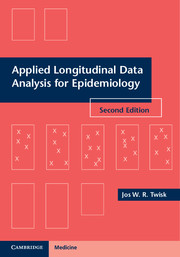Book contents
- Frontmatter
- Contents
- Preface
- Acknowledgements
- 1 Introduction
- 2 Study design
- 3 Continuous outcome variables
- 4 Continuous outcome variables – relationships with other variables
- 5 The modeling of time
- 6 Other possibilities for modeling longitudinal data
- 7 Dichotomous outcome variables
- 8 Categorical and “count” outcome variables
- 9 Analysis of experimental studies
- 10 Missing data in longitudinal studies
- 11 Sample size calculations
- 12 Software for longitudinal data analysis
- 13 One step further
- References
- Index
4 - Continuous outcome variables – relationships with other variables
Published online by Cambridge University Press: 05 May 2013
- Frontmatter
- Contents
- Preface
- Acknowledgements
- 1 Introduction
- 2 Study design
- 3 Continuous outcome variables
- 4 Continuous outcome variables – relationships with other variables
- 5 The modeling of time
- 6 Other possibilities for modeling longitudinal data
- 7 Dichotomous outcome variables
- 8 Categorical and “count” outcome variables
- 9 Analysis of experimental studies
- 10 Missing data in longitudinal studies
- 11 Sample size calculations
- 12 Software for longitudinal data analysis
- 13 One step further
- References
- Index
Summary
Introduction
With a paired t-test and multivariate analysis of variance (MANOVA) for repeated measurements it is possible to investigate changes in one continuous variable over time and to compare the development of a continuous variable over time between different groups. These methods, however, are not suitable for analysis of the longitudinal relationship between a continuous outcome variable and several covariates (which can be either continuous, dichotomous, or categorical). Before the development of “sophisticated” statistical techniques such as generalized estimating equations (GEE) analysis and mixed model analysis, “traditional” methods were used to analyze longitudinal data. The general idea of these “traditional” methods was to reduce the statistical longitudinal problem into a cross-sectional problem. Even nowadays these (limited) approaches are sometimes used in the analysis of longitudinal data.
“Traditional” methods
The greatest advantage of the “traditional” methods is that cross-sectional statistical techniques can be used to analyze the longitudinal data. The most commonly used technique for reducing the longitudinal problem to a cross-sectional problem is analysis of the relationships between changes in different parameters between two points in time (Figure 4.1). Because of its importance and its widespread use, a detailed discussion of the analysis of changes will be given in Chapter 9.
- Type
- Chapter
- Information
- Applied Longitudinal Data Analysis for EpidemiologyA Practical Guide, pp. 51 - 85Publisher: Cambridge University PressPrint publication year: 2013
- 1
- Cited by



